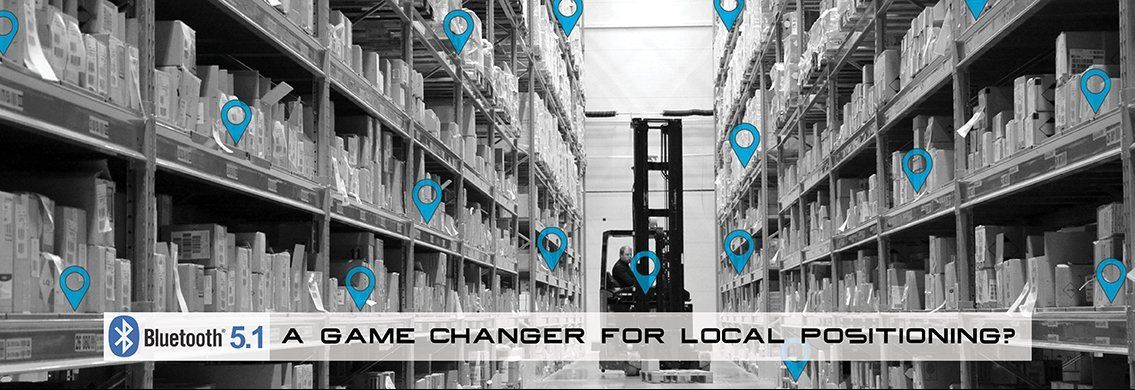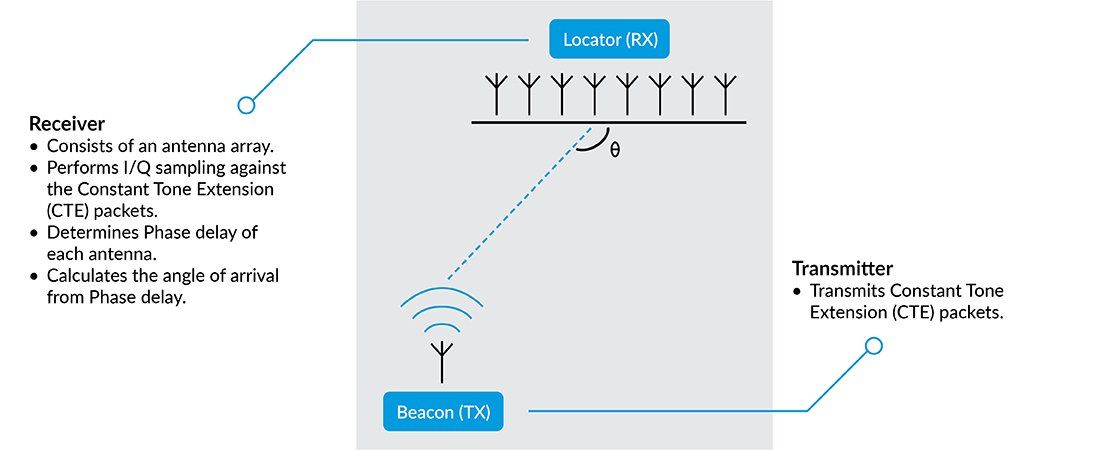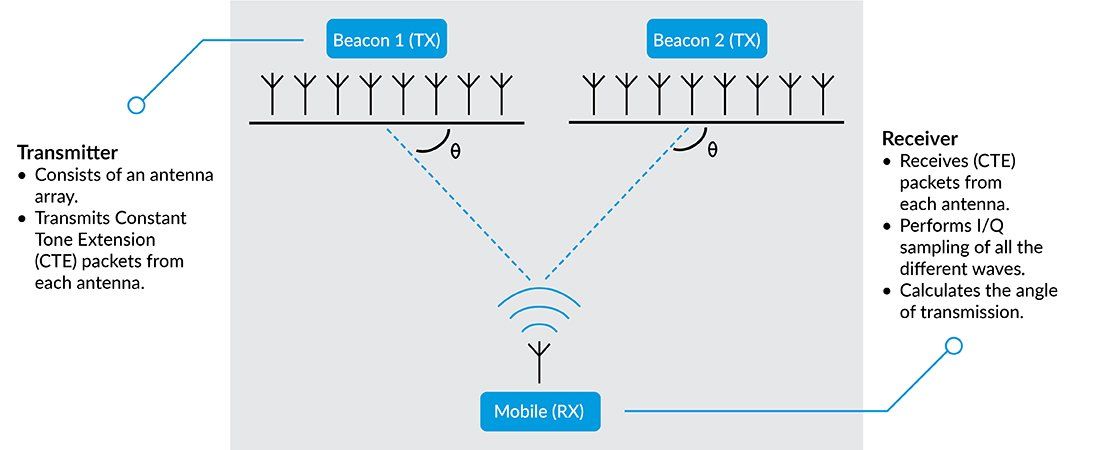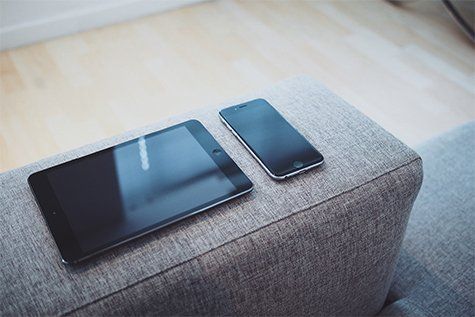Beta Solutions Blog
Bluetooth 5.1 - A game changer for local positioning?
Date: April 8, 2020
Author: Siddharth Venkatesh, Intern
Bluetooth 5.1 is the latest iteration of the wireless technology, and introduces the ability to detect the Angle Of Arrival of the wireless signal. Such disruptive technology introduces a vast range of new opportunities - such as going a long way to solve the present issues with Local Positioning Systems.
Bluetooth Technology - A Quick Recap
Bluetooth is no doubt a word we have all heard. Since the advent of version 1.0 in 1999, the technology has become synonymous with short range wireless communication found in consumer electronics today. Indeed, whether it is to transfer files between devices or listen to our favorite songs using wireless headphones - Bluetooth is often the technology of choice.
Bluetooth operates by using (short range) UHF radio waves at a frequency band of 2.4GHz to 2.48GHz. Incidentally, this is the same frequency band as another popular wireless communication protocol - Wi-Fi. However, these are two very different protocols and intended for very different applications. Bluetooth technology devices transmit a much weaker signal than Wi-Fi and therefore are intended for short range applications. The upside of this is significantly reduced power consumption, and therefore longer battery life.
Bluetooth has evolved markedly over the years.
- Versions 1-3 (now known as “Bluetooth Classic”) was a point to point (1:1) topology - enabling various devices to pair together and exchange data.
- Version 4 (known as “Low Energy”), introduced in 2010 - is a point to many (1:M) topology. That is, Beacons can “broadcast” their data to many Receiver Nodes. Additionally, the technology was designed to be ultra low power - enabling low power wireless sensing.
- Version 5 (“Mesh”) was first introduced in 2016, and is a many to many (M:M) topology. Any nodes can talk to any other nodes, enabling large device networks. You can read more about this in our Blog A Closer Look at the New Bluetooth Mesh from 2017.
- Version 5.1, as we will see, is a further advancement on the BT Mesh protocol - and introduces a very exciting new feature.
Bluetooth 5.1
Bluetooth Special Interest Group (SIG) announced in January 2019 that 5.1 would include new “direction finding” technology. Undoubtedly, being able to determine the position of an object will unlock a wide range of commercial opportunities.
While Global Navigation Satellite Systems (GNSS) are relatively good at resolving positions, they will only work if the GNSS receiver can “see” 3 or more satellites - making them unsuitable for indoors.
Current Indoor Positioning Systems use the Received Signal Strength Indication (RSSI) technology to triangulate the position of other Bluetooth devices. This often requires multiple receivers (more the better) to “resolve” the transmitter’s location - and the end results are still often not highly accurate.
This new direction-finding technology, however, calculates the angle of transmission of the Bluetooth device to accurately pinpoint its location. This technology is three times more accurate than RSSI technology1.
There are two methods for direction finding, the Angle of Arrival (AoA) and Angle of Departure (AoD) methods - which are briefly described as follows:
Angle of Arrival (AoA):
- The Angle of Arrival method consists of an antenna array on the receiver end. At least two antennas are required - but more antennas will enable more direction precision.
- The transmitter emits what is called a “Constant Tone Extension” packet, which is received by the receiver's antennas and ultimately sampled and digisited both In-phase and Quadrature components (IQ) - and by the Bluetooth receiver’s circuitry.
- Essentially, as each of the antennas will receive the packet at a different phase, this phase delay can be used to determine the AoA of the transmission.
Figure 1. Angle of Arrival (AoA)1
Angle of Departure (AoD)
- The Angle of Departure method also consists of an antenna array, but on the transmission end.
- Each antenna in the array transmits a Constant Tone Extension (CTE) packet which again is IQ sampled in the receiver by a single antenna.
- Based on the samples, the angle of transmission can be calculated.
Figure 2. Angle of Departure (AoD)1
It is important to note that 5.1 technology only provides inherent object direction information and not object position - as distance information is not included. However, as per existing methods, Distance (and therefore position) can be approximately deduced by measuring the received signal strength.
Bluetooth 5.1 Applications
While most people are familiar with the consumer sector of the Bluetooth market (e.g.: audio, wearables, entertainment, personal handhelds, etc.), it is increasingly being used in industry and other IOT applications. Some possible applications are listed below:
Smart Buildings
There is an increasing demand for smart buildings in today's economy. Smart buildings encompass airports, offices, hospitals, museums etc. Bluetooth 5.1 applications such as wayfinding and asset management in buildings help improve the occupant experience and operational efficiency of the building.
- Wayfinding in Buildings:
Devices such as phones, tablets and PC’s can be used to connect to bluetooth nodes placed inside buildings to accurately provide pathfinding functionality. These nodes can be strategically placed to provide the optimum route to your destination. - Asset Management in Offices:
Large offices and hospitals are equipped with many assets. Accurately tracking the location of these assets is presently difficult and can lead to delays and inefficiencies. With embedded bluetooth tags in all assets, the location of each one can be monitored continuously, improving asset management.
Smart Homes
With the advent of home automation, smart homes have become widely popular within the market. Home automation encopasses a range of products such as portable speakers, smart locks, smart switches etc. These products aim to provide security, dependability and reduced power consumption to homes.
Personal Property Tags
The introduction of Bluetooth 5.1 has opened up another avenue in home automation. The new direction finding functionality allows for tracking personal items within the household. With bluetooth enabled nodes placed in each room, there will be no more frantic searches for keys in the morning before work! Favoured personal items can be embedded with a bluetooth 5.1 tag which will allow for continuous tracking of those items.
Figure 5. Personal Property Tags
Smart Industry
With the industrial IOT revolution, bluetooth has helped manufacturers achieve an increase in productivity. Smart Industry has helped reduce operational costs and increase efficiency2.
Asset Tracking
With thousands of assets moving in and out of warehouses, a reliable method of tracking these assets is required. This is where Bluetooth 5.1 comes in. With its accurate direction finding capability, manufacturers will be able to track the location of these assets in the warehouse at any time. Moreover, since the tags embedded in these assets are bluetooth enabled, they will be able to store and communicate details about the asset themselves.
Figure 6. Asset Tracing in Warehouses
Conclusion
The introduction of Bluetooth 5.1’s new direction finding capabilities is certainly changing the game in terms of indoor direction finding - with it now being possible to resolve an object's position to a much greater resolution than traditional RSSI triangulation methods.
Beta Solutions has experience with developing BT 5.1 technology and if you have an idea of how you could use 5.1, or need advice regarding hardware or firmware design techniques for Bluetooth Networks - feel free to get in touch with the team at Beta Solutions!
References:
- Bluetooth Direction Finding: Angle of Arrival (AoA) and Angle of Departure (AoD). (2020, January 24). Retrieved from
https://www.silabs.com/products/wireless/learning-center/bluetooth/bluetooth-direction-finding
- 2020 Bluetooth Market Update. Retrieved from
https://www.bluetooth.com/bluetooth-resources/2020-bmu/
- Images retrieved from https://www.pexels.com







